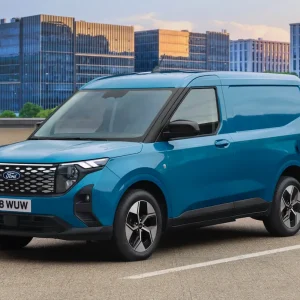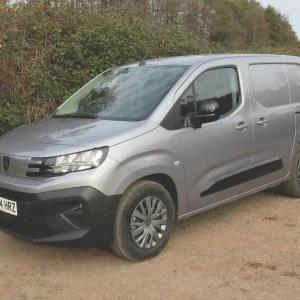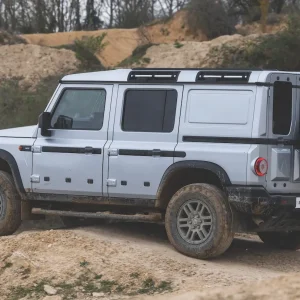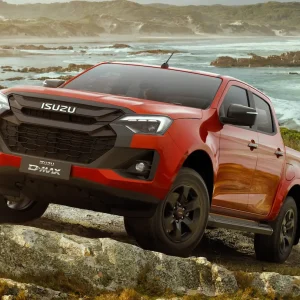Volkswagen’s sixth-generation Transporter arrives in the UK in September with the brand determined to reaffirm the model’s status as the benchmark product in the medium van sector.
This is a position that the legendary T-series van has arguably relinquished to Ford’s excellent Transit Custom, which has enjoyed almost unanimous critical acclaim since its introduction in 2012. Stiff competition is also provided by the Renault Trafic/Vauxhall Vivaro pairing, not to mention Mercedes’ new Vito.
Volkswagen has certainly kept the light commercial vehicle world waiting for the T6. Many expected the manufacturer to unveil the new van at its home town commercial vehicle show in Hanover, Germany, in September last year, but we had to make do with perusing the Tristar pick-up concept, which the brand insists offered styling clues as to the T6, and while the faces on the two vehicles are indeed strikingly similar, it is harder to marry the Tristar’s futuristic interior with the T6’s more functional, prosaic cab.
First pictures of the new production model itself emerged in April following a static unveiling, and in late June we finally got to drive the van.
It comes with six decades of history behind it and a big reputation to live up to.
The T1 debuted in the UK at the Earls Court motor show in 1954 and VW claims “it has been the blueprint for the panel van ever since”. Total UK sales have now surpassed 300,000 units, and when the fifth-generation T5 appeared in 2003 it promptly scooped What Van?’s Van of the Year Award.
The Transporter’s high standing in the industry also saw it inducted into the What Van? Hall of Fame for 2015.
The T5 raised the bar in terms of load-lugging capacity compared with the T4, with top payload going up from 1165kg to 1331kg and the maximum load volume increasing from 7.8m3 to 9.3m3 – figures that VW has retained for the T6.
By way of comparison, the Ford Transit Custom range offers a maximum load space of 8.3m3 and a upper limit payload of 1442kg while the Renault Trafic tops out at 8.6m3 and 1250kg respectively – figures shared by Vauxhall’s version of the van, the Vivaro.
The sixth-generation Transporter panel van line-up will be priced from £17,745 for the 84hp 2.0-litre T26 (2.6t) SWB five-speed manual Startline model to £31,275 for the 180hp 2.0-litre T32 LWB Highline 4Motion with seven-speed DSG transmission. Its key rival, the Transit Custom, is priced from £18,295 to £26,345 and the Renault Trafic goes from £18,245 to £23,445. All prices exclude VAT. Prices for the passenger-carrying Transporter Kombi start at £19,840 and rise to £32,700.
The Transporter is VW’s biggest UK seller, above the Caddy light van, and the new model will be available in the brand’s established band of three trim levels. Startline models include standard features such as Bluemotion Technology (with stop/start, regenerative braking and low rolling-resistance tyres), DAB+ digital radio, five-inch touchscreen, Bluetooth phone connectivity and USB connection. Also included is Volkswagen’s Automatic Post Collision Braking system, which automatically applies the brakes after a collision, reducing the risk of a secondary impact.
Prices for Trendline models step up £2010 from the entry-level trim to start from £19,755, and in addition to Startline get new Simora cloth upholstery and a multi-function display.
Trendline models also come with new wheel trims, a full-height steel bulkhead in the panel van, body-coloured bumpers and rear parking sensors. A Comfort pack consisting of foldable grab handles on A-pillars, additional storage compartments, dimmable cabin lights and additional noise suppression is also fitted as standard.
Flagship Highline models are priced from £21,315, a £1560 hike from Trendline. Among the new features introduced to the sixth-generation version are a leather multi-function steering wheel, heated windscreen, automatic driving light control, daytime running lights and 16-inch Clayton alloy wheels (17-inch Richmond alloys on the T32 and/or 180hp engine). Highline models also come with front fog lights with cornering function and a Thatcham Category 1-approved alarm as standard.
The new Transporter is up for grabs in three roof heights, four gross vehicle weights (2.6–3.2t) and with two wheelbases.
From launch, the Transporter engine range consists of 2.0-litre TDI Euro5 engines with outputs of 84hp, 102hp and 140hp, although the Highline trim is also available with a 180hp unit. VW is also offering a 2.0-litre TDI Euro6 unit that develops 102hp in the first tranche of models and will supplement this with 150hp and 204hp Euro6 powertrains over the next 12 months.
All 84hp and 102hp engines are fitted with a five-speed manual gearbox as standard, with 140hp and 180hp units equipped with either a six-speed transmission as standard or an optional seven-speed DSG automatic.
VW said it will add a Bluemotion model to the order book later this year, but initially the most efficient version will be the 102hp 2.0-litre Euro6 SWB panel van, which it claimed can return 47.9mpg on the combined cycle (a 10.2mpg improvement over its predecessor) and emits 153g/km of CO2 (a reduction of 45g/km).
The greenest Transit Custom currently on offer is the 100hp 2.2-litre Euro5 Econetic, which emits 162g/km and returns 46.3mpg. The 120hp 1.6 bi-turbo engine installed in the Renault Trafic and Vauxhall Vivaro has official consumption of 47.9mpg and CO2 of 155g/km.
In a groundbreaking move for the medium van sector, VW is to introduce two petrol engines to the line-up in 2016 with outputs of 150hp and 204hp. Recent publicity about the harmful affects of NOx emissions and particulates to air quality has triggered interest from fleets in petrol powertrains, but VW admits volumes are likely to be low.
As with the new Caddy we reviewed in July, VW has not gone in for a radical styling overhaul for its new Transporter – sharper contours on the front end are almost all that distinguishes the exterior from the T5 and the load area remains unchanged too.
An advantage of this is that existing customers with bespoke racking equipment will be able to transfer it intact into their new vans.
We got behind the wheel of the Euro6 SWB, low-roof 102hp derivative (projected to be the big volume engine with 70% of sales), which, from launch at any rate, is the most frugal T6 available. The model we drove was in continental, left-hand drive specification, but we reckon it corresponded most closely to the Trend trim that will come to the UK.
The van has a neat, tidy and functional appearance that nevertheless lacks the charm that made customers take its predecessors to their hearts. The 5.8m3 886kg load bay is accessed by twin rear doors opening to 180° and a nearside side door. Incidently, as it doesn’t require a 13-litre Adblue tank, the Euro5 equivalent of the 102hp version offers a payload of 913kg.
The cabin is protected from the load box by a full-height steel bulkhead, but it is worth noting that on the entry-level Startline this would need to be purchased as a £190 option.
Build quality is a strong point of VW’s commercial vehicles, and once the doors have shut with a pleasing clunk you notice that everything inside the cab has a robust feel to it and the controls are all sturdily put together and easy to understand.
A useful new feature is the extra 12V power socket on top of the dashboard that provides a convenient place for the driver to plug in a satnav device. A pair of cup holders are also within easy reach on the dash top, and while there are plenty of cubbyholes to store oddments and large buckets for water bottles in the doors, there is no overhead shelf.
The middle seat does, of course, contain a pull-down table to give the cabin the ‘mobile office’ credibility so beloved of manufacturers’ marketing managers. However, there is no feature such as the load-through hatch underneath the outside passenger seat like Ford introduced on its Transit Custom to accommodate the stowage of long items.
The driver’s seat is comfortable, supportive and adjustable for height, reach and lumbar support, and the steering column is both reach and rake-adjustable.
Cruise control is standard on Trendline models, but if you plump for Startline you’ll have to fork out £105 to get it fitted. Our test van came with a media system incorporating satnav, but this will be a £120 extra on both Trendline and Highline versions.
The 102hp drivetrain, which is the second lowest-powered available after the 84hp, may be best suited to urban operations and the likely choice of fleets, but we found it offered ample power on motorways and winding country roads too, even with a half-load in the back, and it also enables the van to move smoothly away from very low speeds in second gear. The five-speed manual ’box is slick and combines well with the van’s sharp, firm handling and well-weighted, precise steering.
Ride quality is class-leading and means you arrive at your destination feeling fresh, and refinement levels are equally impressive, although road and wind noise did make a softly spoken colleague hard to hear at motorway speeds.
We also got to try the 140hp engine with six-speed transmission in a high-roof derivative and would recommend this unit for those looking for a generous amount of added oomph.





